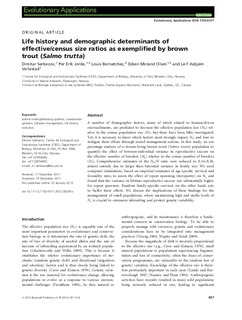Life history and demographic determinants of effective/census size ratios as exemplified by brown trout (Salmo trutta)
| dc.contributor.author | Serbezov, Dimitar | |
| dc.contributor.author | Jorde, Per Erik | |
| dc.contributor.author | Bernatchez, L | |
| dc.contributor.author | Olsen, Esben Moland | |
| dc.contributor.author | Vøllestad, Leif Asbjørn | |
| dc.date.accessioned | 2018-08-01T11:37:24Z | |
| dc.date.available | 2018-08-01T11:37:24Z | |
| dc.date.created | 2012-12-11T08:28:59Z | |
| dc.date.issued | 2012 | |
| dc.identifier.citation | Evolutionary Applications. 2012, 5 (6), 607-618. | nb_NO |
| dc.identifier.issn | 1752-4571 | |
| dc.identifier.uri | http://hdl.handle.net/11250/2507117 | |
| dc.description.abstract | A number of demographic factors, many of which related to human-driven encroachments, are predicted to decrease the effective population size (Ne) relative to the census population size (N), but these have been little investigated. Yet, it is necessary to know which factors most strongly impact Ne, and how to mitigate these effects through sound management actions. In this study, we use parentage analysis of a stream-living brown trout (Salmo trutta) population to quantify the effect of between-individual variance in reproductive success on the effective number of breeders (Nb) relative to the census number of breeders (Ni). Comprehensive estimates of the Nb/N ratio were reduced to 0.16–0.28, almost entirely due to larger than binomial variance in family size. We used computer simulations, based on empirical estimates of age-specific survival and fecundity rates, to assess the effect of repeat spawning (iteroparity) on Ne and found that the variance in lifetime reproductive success was substantially higher for repeat spawners. Random family-specific survival, on the other hand, acts to buffer these effects. We discuss the implications of these findings for the management of small populations, where maintaining high and stable levels of Ne is crucial to extenuate inbreeding and protect genetic variability. | nb_NO |
| dc.language.iso | eng | nb_NO |
| dc.title | Life history and demographic determinants of effective/census size ratios as exemplified by brown trout (Salmo trutta) | nb_NO |
| dc.type | Journal article | nb_NO |
| dc.type | Peer reviewed | nb_NO |
| dc.description.version | publishedVersion | nb_NO |
| dc.source.pagenumber | 607-618 | nb_NO |
| dc.source.volume | 5 | nb_NO |
| dc.source.journal | Evolutionary Applications | nb_NO |
| dc.source.issue | 6 | nb_NO |
| dc.identifier.doi | 10.1111/j.1752-4571.2012.00239.x | |
| dc.identifier.cristin | 970887 | |
| dc.relation.project | Norges forskningsråd: 179569 | nb_NO |
| cristin.unitcode | 7431,0,0,0 | |
| cristin.unitname | Havforskningsinstituttet | |
| cristin.ispublished | true | |
| cristin.fulltext | original | |
| cristin.qualitycode | 1 |
Tilhørende fil(er)
Denne innførselen finnes i følgende samling(er)
-
Articles [3001]
-
Publikasjoner fra CRIStin [3023]
